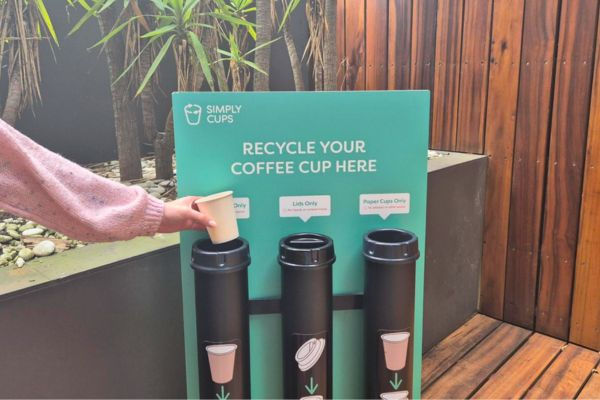What is e-waste?
- Simply Cups

- Sep 12, 2023
- 3 min read
Updated: Sep 16, 2024
E-waste refers to broken, discarded or unusable electronic devices such as cords, batteries, computers, smartphones and appliances (to name a few).
With the rise of technology and small gadgets, we are seeing increasing rates of e-waste throughout Australia.

Why is e-waste a problem?
Sending e-waste to landfill poses numerous significant environmental risks. E-waste is fast growing waste stream and is expected to rise by 30% by 2030.
Contaminates the soil
Many electronic devices or appliances contain hazardous metals such as lead, mercury, and cadmium that can contaminate soil and water sources. E-waste is responsible for 70% of the toxic chemicals found in landfill!
Emits carbon dioxide
Like any other material, e-waste emits carbon dioxide and contributes to our overall carbon emissions.
Loss of rare and valuable materials
Improper processing of e-waste (such as disposing in landfill) results in a significant loss of rare and valuable materials, such as neodymium (magnets in motors), indium (flat screen TVs) and cobalt (batteries) that are difficult to obtain.
Increased demand on resources
Electronic products have a high turnover, therefore placing additional demand on resources such as materials, equipment, labour, utilities, etc.
Examples of e-waste
E-waste is an umbrella term for many electronic items. This includes (but is not limited to):
Televisions (and remote controls)
Computer Items: Laptops, Desktops, Monitors, Keyboards, Mice, Printers, web cam, usbs, hard drives, iPads
Consoles and handheld video games
Mobile phones
Batteries
Lighting: Fluorescent lamps, down lights, torches
Household appliances: Lamps, sewing machines, kettle, fans, microwaves, coffee machines, toasters, hair dryers, irons, clocks, radios
White goods: Fridge, freezer, washing machine, air conditioner
Toys or musical instruments with leads or batteries
Cables and leads
Australian bans on e-waste
Australia does not have any national bans on e-waste, but there are State specific restrictions.
WA: ban on e-waste to landfill by 2024 VIC: e-waste to landfill has been banned since 2019 NSW: no ban in place ACT: e-waste to landfill has been banned since 2013 QLD: no ban in place TAS: no ban in place NT: no ban in place but penalties for illegal dumping SA: e-waste to landfill has been banned since 2016
What should I do with e-waste?
E-waste needs to be disposed of correctly and should not be sent to landfill.
Recycling centres and designated drop-off/collection points are available across the country for you to safely discard of your e-waste, such as:
Batteries can be disposed at many locations, including Aldi, Battery World, Bunnings, Vinnies, and through B-cycle. N.b. even dead batteries can still have some charge, so it’s important to tape the end ‘terminals’ before recycling.
Many electronics can be collected with emeals. Emeals will also donate 5 meals to those in need via Second Bite.
Computers, monitors, laptops, keyboards, computer mice, printers, scanners, webcams, computer cables, chargers, hard drives and motherboards can all be disposed of through the National Television and Computer Recycling Scheme. There are also several independent companies that recycle, refurbish or reuse computers and accessories in Australia. Find a recycler near you here.
Some light globes can be recycled, but not in kerbside collections. Fluorescent tubes and compact fluoros can be recycled through specific council programs. Find a drop off location near you here. Older style globes that aren’t accepted can be wrapped in paper and put in general waste.
Mobile phones can be recycled through the Mobile Muster program, which transforms the components from mobile phone waste into valuable materials for reuse. There are many drop off points across Australia, and there’s also a collection service available.
There are lots of ways to recycle your old white goods or donate them if they still work. Many commercial recyclers will accept old white goods, and there are also lots of options for reuse and refurbishment. Find a local recycler via Planet Ark here.
Some of these are paid services.
What else you can do?
There are steps we can take as consumers to limit the amount of e-waste that ends up in landfill.
Repair
Get your items repaired instead of buying a new item. Repair your iPhone, get your dishwasher checked out, fix your cables ... All these small changes can and will reduce our impact on our environment.

Buy smarter
There are many retailers, stores and online marketplaces that offer discounted/repaired electronic goods for sale at a reduced price. Some of these places also provide warranties for peace of mind for the product’s durability.
Second hand
Consider renting electronic goods that will only be used for a short period of time. This can be a more cost-effective way to use short-term electronics goods.



